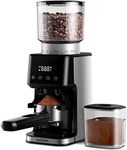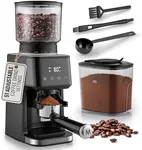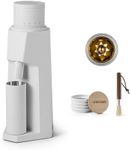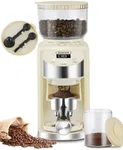Buying Guide for the Best Espresso Grinders
Choosing the right espresso grinder is crucial for achieving the perfect cup of espresso. The grinder you select will significantly impact the flavor, aroma, and overall quality of your coffee. When picking an espresso grinder, it's essential to consider several key specifications to ensure it meets your needs and preferences. Understanding these specs will help you make an informed decision and enjoy a consistently excellent espresso experience.Grind Size SettingsGrind size settings refer to the range of fineness or coarseness that the grinder can produce. This spec is important because different brewing methods require different grind sizes, and espresso requires a very fine grind. Grinders with more settings offer greater precision and flexibility. If you are an espresso enthusiast, look for a grinder with a wide range of fine settings to achieve the perfect grind for your espresso machine. For beginners, a grinder with fewer settings but good fine-tuning capabilities may suffice.
Burr TypeBurr type refers to the mechanism used to grind the coffee beans. There are two main types: flat burrs and conical burrs. This spec is important because it affects the consistency and quality of the grind. Flat burrs tend to produce a more uniform grind, which is ideal for espresso, while conical burrs are often quieter and can handle a wider range of grind sizes. If you prioritize consistency and precision, a flat burr grinder may be the best choice. If you value versatility and quieter operation, consider a conical burr grinder.
Grind ConsistencyGrind consistency refers to how uniform the coffee particles are after grinding. This spec is crucial for espresso because an inconsistent grind can lead to uneven extraction, affecting the flavor and quality of your espresso. High-quality grinders produce a consistent grind, ensuring a balanced and flavorful shot. If you are serious about your espresso, look for a grinder known for its grind consistency. For casual users, a grinder with decent consistency may be sufficient, but it may require more experimentation to achieve the desired results.
Grind SpeedGrind speed refers to how quickly the grinder can process coffee beans. This spec is important because faster grinders can save time, but they may also generate more heat, which can affect the flavor of the coffee. Slower grinders tend to produce less heat, preserving the coffee's aroma and taste. If you need to grind large quantities quickly, a faster grinder may be beneficial. However, if you prioritize flavor and quality, a slower grinder that generates less heat might be the better option.
Dosing OptionsDosing options refer to the grinder's ability to measure and dispense a specific amount of coffee grounds. This spec is important for achieving consistent results and minimizing waste. Some grinders offer manual dosing, while others have programmable settings for precise dosing. If you prefer convenience and consistency, look for a grinder with programmable dosing options. For those who enjoy more control and experimentation, a manual dosing grinder may be more suitable.
Build QualityBuild quality refers to the materials and construction of the grinder. This spec is important because a well-built grinder will be more durable and reliable over time. High-quality grinders are often made with metal components and sturdy construction, ensuring longevity and consistent performance. If you plan to use your grinder frequently, investing in a high-quality, durable grinder is advisable. For occasional use, a grinder with decent build quality may be sufficient, but it may not last as long or perform as consistently.




















